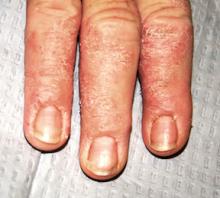HISTORY
Rashes of the hand are commonly seen in both primary care and dermatology practices. Their location makes them problematic, in terms of interference with normal activities and difficulty with treatment.
This 51-year-old man’s rash appeared about a month ago, with no premonitory signs. He has consulted numerous providers about it, including his primary care clinician. That practitioner diagnosed a probable “fungal infection” and prescribed a combination clotrimazole/betamethasone dipropionate cream. The rash subsequently improved, though not substantially.
The patient recalls developing a similar rash several other times during adulthood, but says it was never this severe. His mother has had similar eruptions, as well as sensitive skin in general. Both the patient and his mother are plagued by seasonal allergies, asthma, and sweating of the palms.
EXAMINATION
The distal portions of the second through fourth fingers of the right hand are affected. This is typical, according to the patient. The cuticles of all four affected nails are detached from the nail plates, with two of the three nail plates showing mild transverse ridging.
There is circumferential involvement of the distal half of all four fingers, with a well-defined margin and a blistery look to the papulosquamous process. Neither the left hand nor the feet are impacted.
DISCUSSION
This is a classic picture of a condition that goes by several names, most commonly pompholyx, also known as dishidrotic eczema. Despite the efforts of many investigators, with much information gleaned, it remains quite mysterious. It can be chronic or acute and can closely resemble what is known simply as hand dermatitis.
Pompholyx is associated with atopy in at least 50% of cases (such as this one). Hyperhidrosis of the palms is also common, and resolution of difficult cases has been achieved with injection of botulinum toxin A. This hypothesis is bolstered by the fact that many patients report onset in summer months; however, there are many whose history fails to follow this pattern.
Research has revealed that more than a few patients with pompholyx are allergic to one of several ingested metals, such as nickel and cobalt. But challenge tests with those substances have failed to consistently replicate the eruption.
Stress is another reported factor in the genesis of this condition. It is well known to exacerbate related conditions (eg, atopic dermatitis), but again, many patients deny any such connection.
When confronted with this clinical picture, dermatology providers are trained to look at the patient’s feet, where a flare of tinea pedis can sometimes be found. This common foot infection can, under certain circumstances, trigger a clinically indistinguishable pompholyx-like eruption on the hands, called an id reaction. In these cases, the tinea pedis always precedes the hand rash. Both resolve with adequate treatment (ie, oral antifungals).
The differential also includes irritant or contact dermatitis. However, patients are likely to report a contributing factor early on, lessening the clinical mystery.
A major diagnostic clue in this and similar cases is the effect on the cuticles and nails. Both are good indicators of the chronicity and nature of the problem.
TREATMENT
Treatment of pompholyx is notoriously difficult. Potent topical corticosteroids (eg, clobetasol cream), applied under occlusion to dampened skin at bedtime, are the cornerstone. In this and many such cases, while not curative by themselves, oral antibiotics can help to reduce colonization by staphylococcus.
A two-week course of prednisone (eg, 20 mg bid for a week, then 20 mg/d for another week) can be extremely helpful. Alternatively, an intramuscular injection of triamcinolone (40 to 60 mg) can be used, especially if the patient has a history of reflux or peptic ulcer. Relative contraindications to systemic steroid use include diabetes, poorly controlled hypertension, congestive heart failure, and dementia.
Phototherapy has also been used, but botulinum injection is becoming common in cases in which hyperhidrosis is the major culprit.
TAKE-HOME LEARNING POINTS
• Pompholyx manifests as a papulosquamous, well-defined rash, often composed of tiny fluid-filled blisters, on the fingers and hand.
• The cause of this condition is unknown, but potential triggers include atopy, stress, hyperhidrosis, and ingestion of metals (eg, nickel or cobalt).
• Since acute tinea pedis can trigger a similar eruption on the hands (and responds to oral antifungals, as does pompholyx), checking the patient’s feet can provide a diagnostic clue.
• Patients may find it helpful to apply a potent topical corticosteroid cream (eg, clobetasol) to dampened hands (which allows for increased penetration of the medication) and cover with cotton gloves overnight.

